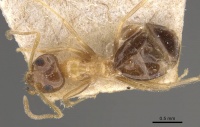Prenolepis dugasi
| Prenolepis dugasi | |
|---|---|

| |
| Scientific classification | |
| Kingdom: | Animalia |
| Phylum: | Arthropoda |
| Class: | Insecta |
| Order: | Hymenoptera |
| Family: | Formicidae |
| Subfamily: | Formicinae |
| Tribe: | Lasiini |
| Genus: | Prenolepis |
| Species: | P. dugasi |
| Binomial name | |
| Prenolepis dugasi Forel, 1911 | |
Nothing is known about the biology of Prenolepis dugasi.
Identification
Williams and LaPolla (2018) - A clypeal tooth with a single seta extending from its point found medially on the anterior border of the clypeus. This species also has three small ocelli on the head.
Although this species most closely resembles Prenolepis melanogaster, the latter is still quite distinct and confusion between the two is very unlikely. Prenolepis dugasi is much smaller in comparison, does not have the distinct body color pattern seen in P. melanogaster (yellow-brown head and mesosoma with dark brown to black gaster), has suberect rather than erect setae on the scapes, and fewer erect macrosetae overall across the head, mesosoma, and gaster. Additionally, P. melanogaster has a head that is broader than long, with scapes that are about a third longer than the head width. Prenolepis dugasi has a head that is about as long as it is broad, and the scapes are about as long as the head is wide. Prenolepis dugasi also has three small ocelli, while P. melanogaster does not have any ocelli at all.
Keys including this Species
Distribution
Distribution based on Regional Taxon Lists
Oriental Region: Vietnam (type locality).
Distribution based on AntMaps
Distribution based on AntWeb specimens
Check data from AntWeb
Countries Occupied
| Number of countries occupied by this species based on AntWiki Regional Taxon Lists. In general, fewer countries occupied indicates a narrower range, while more countries indicates a more widespread species. |

|
Estimated Abundance
| Relative abundance based on number of AntMaps records per species (this species within the purple bar). Fewer records (to the left) indicates a less abundant/encountered species while more records (to the right) indicates more abundant/encountered species. |

|
Biology
Castes
Nomenclature
The following information is derived from Barry Bolton's Online Catalogue of the Ants of the World.
- dugasi. Prenolepis (Nylanderia) dugasi Forel, 1911i: 227 (footnote) (w.) VIETNAM.
- Combination in Paratrechina (Nylanderia): Emery, 1925b: 220.
- Combination in Nylanderia: LaPolla, Brady & Shattuck, 2010a: 127.
- Combination in Prenolepis: Williams & LaPolla, 2018: 175.
Unless otherwise noted the text for the remainder of this section is reported from the publication that includes the original description.
Description
Worker
Williams and LaPolla (2018) - (n=5): CMC: 12–17; EL: 0.16–0.18; HL: 0.67–0.72; HW: 0.61–0.70; MMC: 2–3; PMC: 4–5; PrMC: 2–3; SL: 0.64–0.70; TL: 2.53–2.80; WL: 0.80–0.91; CI: 91–96; REL: 23–25; REL2: 24–26; SI: 99–105.
Light to medium brown, with gaster (and sometimes head) darker than mesosoma; overall cuticle smooth and shiny; decumbent setae on head; long, erect macrosetae on head, mesosoma, and gaster; abundant suberect setae on scapes and legs; head about as long as broad and subtriangular in shape with indistinct posterolateral corners and a straight posterior margin; three small ocelli present; compound eyes moderately large and convex, but do not surpass lateral margins of head in full-face view; torulae do not touch posterior border of clypeus; anterior border of clypeus without prominent anterolateral lobes (Fig 1); single clypeal tooth with an erect seta projecting from its point, located medially on anterior border of clypeus; mandibles with 5 teeth on masticatory margin; ectal surface of mandibles smooth and shiny; in profile view, pronotum is rounded and continuous with mesonotum, which flatly declines posteriorly at a shallow angle before abruptly deepening at mesosomal constriction; propodeum is obtusely angled with flat dorsal and posterior faces; dorsal apex of petiole scale is sharply angled and forward-inclined.
Type Material
Williams and LaPolla (2018) - Lectotype worker (designated here), Vietnam: Cochinchine Française, Region de Moïs; A. Forel (ANTWEB CASENT0911004) (Musee d'Histoire Naturelle Genève). 4 paralectotype workers (designated here), same locality as lectotype (MHNG).
References
- Emery, C. 1925d. Hymenoptera. Fam. Formicidae. Subfam. Formicinae. Genera Insectorum 183: 1-302 (page 220, Combination in Paratrechina (Nylanderia))
- Forel, A. 1911c. Ameisen aus Ceylon, gesammelt von Prof. K. Escherich (einige von Prof. E. Bugnion). Pp. 215-228 in: Escherich, K. Termitenleben auf Ceylon. Jena: Gustav Fischer, xxxii + 262 pp. (page 227, (footnote) worker described)
- Williams, J.L. 2022. Description of Prenolepis rinpoche sp. nov. from Nepal, with discussion of Asian Prenolepis species biogeography. Asian Myrmecology 15, e015008 (doi:10.20362/am.015008).
- Williams, J.L., LaPolla, J.S. 2018. Two new Prenolepis species (Hymenoptera: Formicidae) from Indomalaya and Australasia, with a redescription of P. dugasi from Vietnam. Zootaxa 4441:71-180 (DOI 10.11646/zootaxa.4441.1.10).
References based on Global Ant Biodiversity Informatics
- Chapman, J. W., and Capco, S. R. 1951. Check list of the ants (Hymenoptera: Formicidae) of Asia. Monogr. Inst. Sci. Technol. Manila 1: 1-327
- Forel A. 1911. Fourmis nouvelles ou intéressantes. Bull. Soc. Vaudoise Sci. Nat. 47: 331-400.
- Ogata K. 2005. Asian ant inventory and international networks. Report on Insect inventory Project in Tropic Asia TAIIV: 145-170.
- Williams J. L., and J. S. LaPolla. 2018. Two new Prenolepis species (Hymenoptera: Formicidae) from Indomalaya and Australasia, with a redescription of P. dugasi from Vietnam. Zootaxa 4441:71-180.

